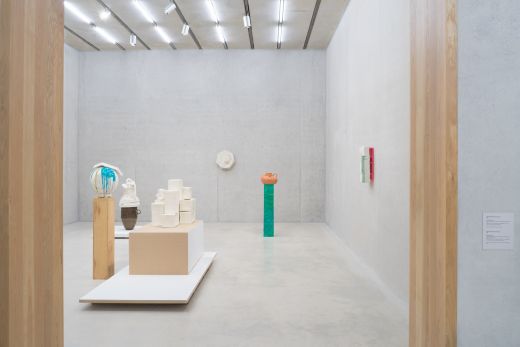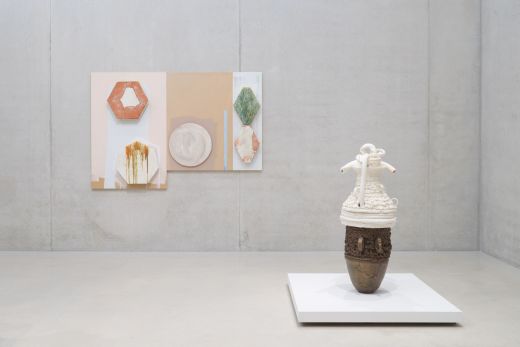Nicole Cherubini
Christy Gast

Installation view of Nicole Cherubini's 500 at the Pérez Art Museum, October 2014-April 2015. Photo by Miami Fine Art.
CHRISTY GAST (RAIL): I’d like to begin talking about your show by discussing your experience of the PAMM building as you toured the site during the construction phase. What were your first impressions of the museum?
NICOLE CHERUBINI: During my first site visit, a hardhat tour, the museum was about halfway constructed. Most of the gallery walls had been poured, but the guts of the building were raw cast concrete and the sheetrock hadn’t been put up in any of the spaces yet. In the gallery where my show is, the walls had been poured and they retained a lot of information from that process—swirls and writing and marks from the forms they were poured into. The most incredible thing that came to me was just how beautiful that poured concrete was. The exterior facade hadn’t been built at all, and the construction crew and the museum staff were all in hardhats. It was kind of incredible.
RAIL: How did those early impressions of the space influence the way you approached making the work in your exhibition?
CHERUBINI: It definitely had an influence on how I used the materials. Knowing that the walls would have texture and patterns led me to rethink how the pieces would exist on them—that there could be a symbiotic relationship between the two where one references the other. The most surprising thing, which I didn’t really understand until I installed, was that because every surface in the gallery is the same material—cast concrete—it was like installing in a seamless space where the work can defy gravity. There was no line between the wall and the floor, which is the most incredible gift for a sculptor. The other thing that struck me was the particular gray tone of the cast concrete, and how my colors were going to be affected by those walls. Colors that seemed a little off in my studio became more vibrant and more subtle at the same time when the work was installed in the gallery. The concrete is a warm gray, it’s not a cool gray, so it warms everything up and balances well with of all the beautiful wood that’s in that space. The museum is incredible.
RAIL: I think about all of the activity that you describe when you toured the site, especially all of the workers in hard hats constructing these floating galleries, and it reminds me of Rudolf Steiner’s lectures on bees, which I know you read when you were researching utopian communities. Do you think a museum can be a utopian space?
CHERUBINI: I’ve thought about that a lot and I see a museum more as a spiritual space. I feel an incredible sense of awe when I’m in a museum…for me it’s like a church. I know that can be a spiritual position, and I would think it depends on the individual. From all the research I did on utopian communities, I believe that many of these movements function through collective consciousness. But for me, the museum evokes a sense of individual spirituality.
RAIL: Interesting, I think of a museum as a civic space, an expression of culture in a community.
CHERUBINI: I don’t necessarily think that a spiritual space isn’t community oriented. I would have to say that those realms are very intertwined. There is an inherent sense of respect in a museum, at least for me there is. I think that these ideas of community, culture and spirituality can come together in a museum.
RAIL: Especially in this museum, with its position at the edge of the city, overlooking the bay. The visual experience can be very meditative in terms of how the artwork is framed within the building and how the view of the water or the city is framed by the building.
CHERUBINI: Completely, and also how the work is framed in relation to every other exhibit in the museum. So there’s an acute sense of awareness that encourages us to make connections and understand different parts as a whole.
RAIL: In your exhibition, I bounce back and forth between formal elements in the work and the built environment. For example, my eye bounces from the thin pedestal wrapped in green plastic to the wall piece with the glassy green glaze on it, and both resonate with the hanging garden column outside, which is visible from the gallery. These repeated forms point back to the hive. Maybe we can talk about that repetition and reproduction and how that relates to your medium—clay.
CHERUBINI: One thing that came together exceptionally well for me in this show is that, moving through the space, each element leads to something else. I love that you referenced the green pedestal, the green glaze, and the hanging foliage. There is an inherent connection between all of these diverse parts, which I tried to manifest formally but also via materials and touch. The physical act of manipulating the clay is what connects the work back to the conceptual underpinnings. There’s a tension between trying to figure out how to actually be in it while making, it as opposed to making the work about it.
RAIL: The materiality of the clay is very evident, every piece bears the imprints you leave as you’re making it—you press slabs into the cardboard box molds, even the bronze piece bears finger impressions. You see the human touch in each of the individual modular units that make up the whole. Your embodiment of utopian craft practices functions on a micro and macro level in the work.
CHERUBINI: Going back to the space as a starting point, the clay pieces on the wall have that gray swirly surface. The glaze I chose deliberately talks to the wall, in the same way the green moves around the room. I wanted the walls to be part of the piece within the space. Placing the unglazed clay pieces on the raw concrete wall creates a physical connection, a material resonance, but the way the light is absorbed by the different materials creates a contrast. I think so often about the way in which unglazed clay absorbs light and glazed clay reflects it, and what that actually says—how the same material can actually have that conversation, one taking in light and one giving it back.

Panel #1 and #2, 2014; Earth Pot #6, 2014. Installation View Pérez Art Museum Miami. Photo by Miami Fine Art.
RAIL: I’m thinking about the feminist adage that “the personal is the political,” and I feel like you have figured out hot to incorporate a feminist ethic into your work in an embodied kind of way—
CHERUBINI: Thank you. That’s the nicest thing anyone has ever said to me. [Laughs.]
RAIL: [Laughs.] So, what is feminism to you? How do you think about it in the studio or in terms of art?
CHERUBINI: I think feminist voices need to be heard in a way that is true and honest within a history that has already been written. The hexagons are my first movement into trying to develop a physical stance for that, because the hexagon is not a closed form, it’s additive. You see one and your mind imagines more and more. I think about trying to pull alternative histories into the conversation, and not just the history of the 1970’s feminist art movement. Artists like Hannah Wilke are beyond important, but I want to look further back. Since I’ve had children, I realize that I can actively shape an existence in this world, which is so important as the world is shying away from a sense of equality between genders. I have realized the responsibility I have now—that our actions today create the conversation for the years to come.
RAIL: I like that you brought up Hannah Wilke and I especially see an affinity with the kneaded eraser and chewing gum pieces. What other artists do you feel a special affinity with?
CHERUBINI: There are sculptors working in clay who have definitely been influential to me, like Beverly Semmes and Rebecca Warren, a group of artists who are well known as ceramics people. They have given me the strength to keep going with it. I recently saw a show of Charles Long’s brass pieces, and I’ve loved his works for years. I look a lot at painting- Rebecca Morris is one of my favorites. I sometimes wish I could exist in one of them. And I like a lot of like really old pottery, like Greek pottery, and the American potter George Ohr. I’m kind of all over the place.
RAIL: My last question is about ceramics in academia right now. A lot of professors who taught our generation of artists are retiring, and I’ve been seeing ads for academic positions in ceramics. Ceramics programs are kind often interesting within university art departments because in order for them to function they have to have a lot technology and equipment and it has to be well-maintained and functional—unlike film or photo departments, for example, which sometimes shift to digital and shed their darkrooms. When someone retires and these positions are advertised, universities are looking for artists who can bridge the gap between technical knowledge and a more conceptual position of the medium in contemporary art. This can override the fine craft aspect of ceramics. What do you think about that kind of transition in terms of the future of the medium?
CHERUBINI: What I really appreciate about ceramics departments is that they are actually multidisciplinary, incorporating fine art sculpture, as well as function and craft, and then it also has a design element to it that is very present. In some ways, I kind of think it’s like the most community-based and maybe contemporary department that can exist. It’s wonderful to bring new people in, which creates a new perspective on the material that doesn’t have to be embodied in the history. But there is also something powerful about that restraint of being beholden to history. I’m actually very conflicted on the whole subject. My husband is a potter, and I have a very close relationship to the material and to the fact that there are so few schools where one can learn to be a really good potter. It would be a shame if that all disappeared.










